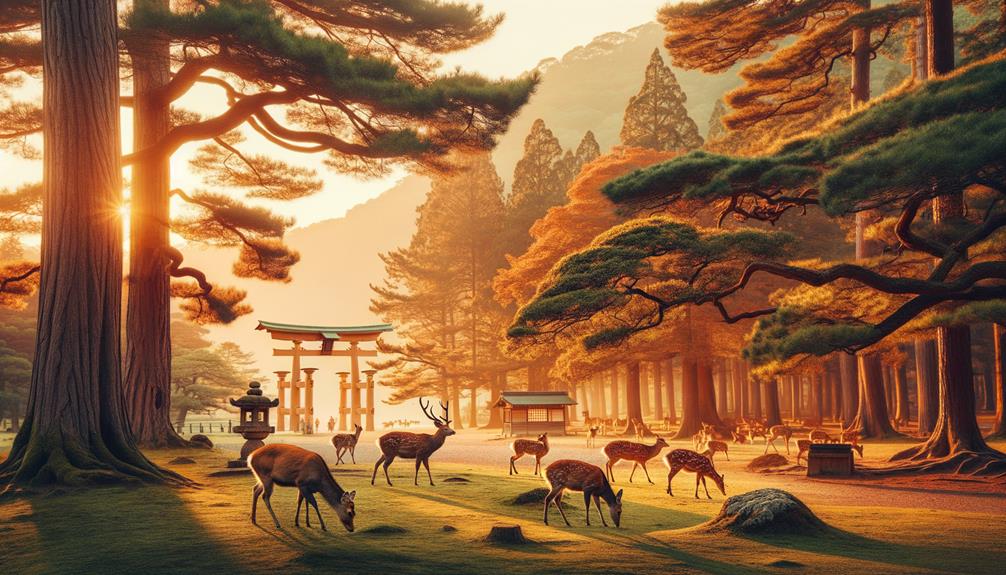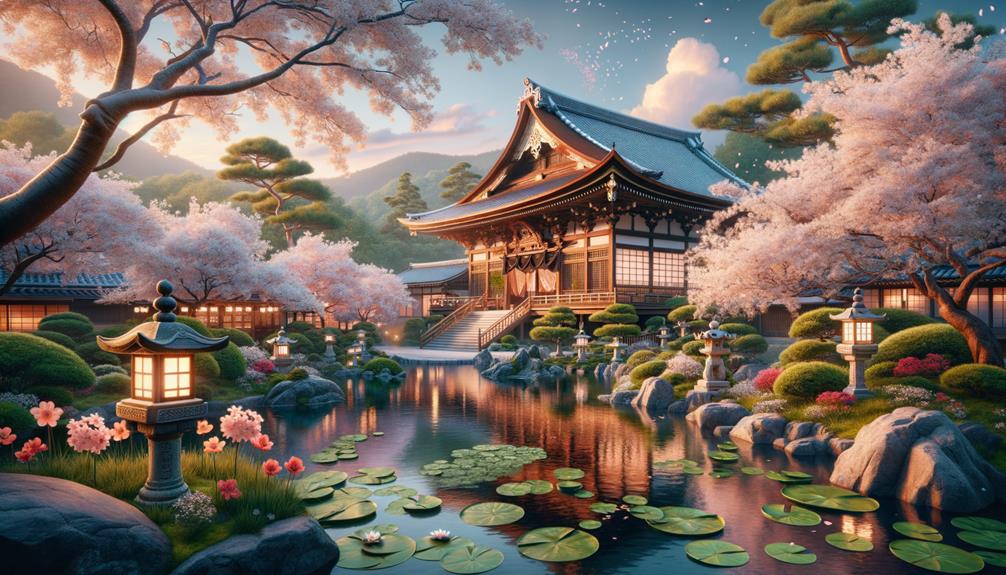Walking into Nara Deer Park felt like stepping into a scene from an ancient Japanese scroll. As I wandered through the park, I was amazed by the gentle deer, seen as sacred messengers of the gods. Feeding them shika senbei, or deer crackers, took some skill to avoid getting mobbed by these eager animals. The mix of natural beauty—from cherry blossoms to autumn leaves—and the nearby temples like Todai-ji made my visit even more special. But there was one part of the park that truly stood out to me…
Getting to Nara Deer Park
Getting to Nara Deer Park was surprisingly easy. It took just a 20-minute walk from JR Nara Station. As I made my way through the charming streets of Nara, I could feel the anticipation building. The mix of urban life and nature was seamless.
The moment I stepped into the park, I was met with the incredible sight of free-roaming deer. These sacred animals, considered messengers of the gods, moved gracefully among the visitors, creating a magical atmosphere. I couldn't resist buying some deer crackers for 150 yen to feed them. The deer, sensing the treats, approached with a mix of curiosity and confidence.
Interacting with these beautiful creatures was thrilling, but I was careful to remember the signs reminding visitors that the deer are wild. A few overzealous moments of feeding led to some playful nudges, a gentle reminder of their untamed nature. The park's open access and lack of admission fees made it a liberating and budget-friendly adventure, ideal for any animal lover looking for a unique cultural experience.
Best Times to Visit
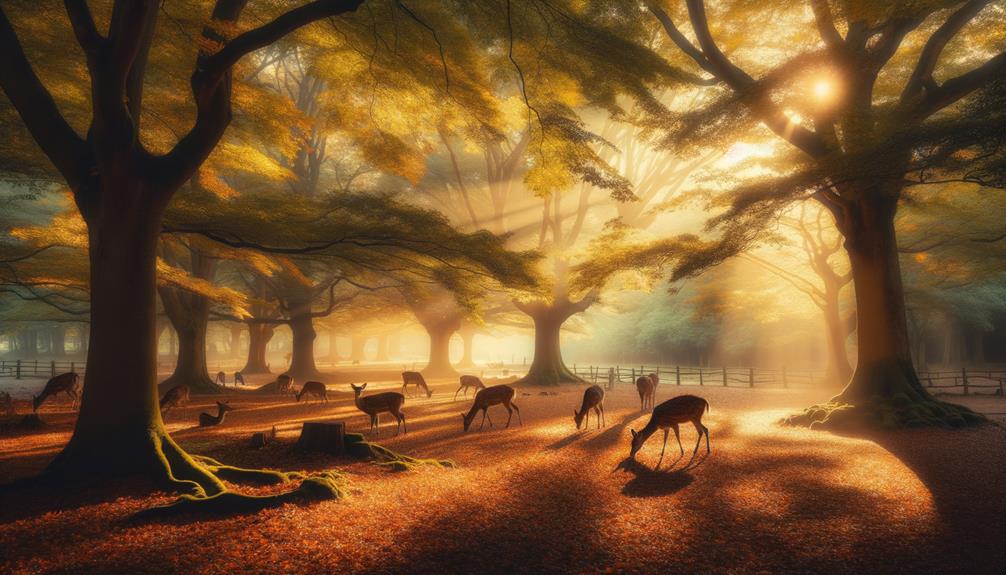
I remember the stunning beauty of Nara Deer Park during cherry blossom season. The pink petals created a magical backdrop for the friendly deer. Visiting early in the morning was peaceful and allowed me to avoid the midday crowds and summer heat. The calm atmosphere on weekdays made it feel like I had the park all to myself, which was a rare and special moment.
Peak Seasonal Highlights
When planning a visit to Nara Deer Park, the cherry blossoms in spring and the vibrant autumn leaves are truly the best times to enjoy the park's beauty. In the spring, the park turns into a sea of pink and white as cherry trees bloom, creating a stunning floral canopy. Walking under those delicate petals feels almost dreamlike, surrounded by nature at its finest.
Autumn is just as beautiful. The trees burst into colors of red, orange, and gold, turning the park into a picturesque landscape. The crisp air during this time adds a refreshing touch to the experience. The scenery during these peak seasons looks like something out of a postcard.
Yes, the park gets crowded during these times, but it's worth it for the amazing natural beauty. Every corner of the park offers a perfect photo opportunity, making each visit memorable. Whether it's the soft pastels of spring or the fiery hues of fall, Nara Deer Park's seasonal charm never disappoints.
Optimal Visit Hours
If you want to truly appreciate the peaceful charm of Nara Deer Park and have quality moments with the deer, try to visit early in the morning or late in the afternoon. These times help you avoid the crowds and the midday heat. The park turns into a calm retreat, with deer being most lively and friendly.
| Time of Day | Experience |
|---|---|
| Early Morning | Quiet, cool, deer bowing |
| Late Afternoon | Calm, colorful leaves |
| Midday | Busy, hot |
| Evening | Quiet, feeding times |
Early mornings are particularly special, as the deer often bow in anticipation of being fed. During cherry blossom season and autumn, the park's beauty is unmatched, with vibrant colors adding to the peaceful atmosphere. I recall one crisp autumn morning, walking through the colorful leaves and feeling deeply connected to the serene environment.
To get the most out of your visit, plan around the deer feeding times, typically in the early morning or late afternoon. Weekdays are usually quieter, offering a more personal experience with these gentle animals. Being able to wander and interact without the crowds truly makes the visit special.
Deer Interaction Tips

When I first saw the deer bowing for crackers, I was charmed but quickly realized the need to be careful while feeding them. It's important to understand their behavior; they might nudge you for more food, but sudden movements or trying to pet them can cause unexpected reactions. Always be respectful and cautious to ensure a pleasant experience for both you and the deer.
Feeding the Deer Safely
I bought a pack of deer biscuits for just 150 yen and was immediately taken by the sight of the deer bowing, eager for their treat. Nara Park is famous for these wild deer, but it's important to follow the guidelines for safe feeding. The biscuits are made specifically for the deer to keep them healthy and friendly.
As I got closer, a deer bowed gracefully, ready for a snack. This act, a blend of training and natural curiosity, felt almost magical. However, it's good to remember that these deer, despite their calm behavior, are still wild animals. Signs around the park warn that they can get aggressive if provoked, so treating them properly is key.
To keep things safe and fun, I followed the park's rules. I didn't tease the deer with food or make any sudden moves. Their bowing was sweet, but they could quickly change if they felt threatened. By respecting their space and feeding them properly, I helped keep the peace between visitors and deer. Nara Park offers a truly special experience, combining nature, culture, and mutual respect.
Understanding Deer Behavior
Watching the deer at Nara Park, I quickly noticed their interesting mix of curiosity and caution. These sacred animals from Japanese folklore roam freely, showing a unique balance—they're wild yet remarkably tame due to constant human interaction. Their interactions with visitors, especially during feeding sessions with special deer crackers, are both charming and educational.
However, it's important to treat the deer with respect. Despite their generally gentle nature, signs warning of potential aggression remind us that they can feel threatened. Here's a quick guide to their behavior:
| Behavior | Meaning |
|---|---|
| Bowing | Asking for deer crackers |
| Stomping | Feeling threatened or annoyed |
| Gentle nudging | Seeking attention or food |
| Headbutting | Aggressive behavior, feeling provoked |
| Following closely | Curiosity or expecting more food |
In one memorable moment, a deer nudged me gently, a soft reminder of its tame nature. But, pay attention to signs of aggression—stomping or headbutting means they're uncomfortable. By understanding these signals and respecting their sacred status, we ensure a harmonious experience in this unique blend of nature and culture.
Must-See Temples and Shrines
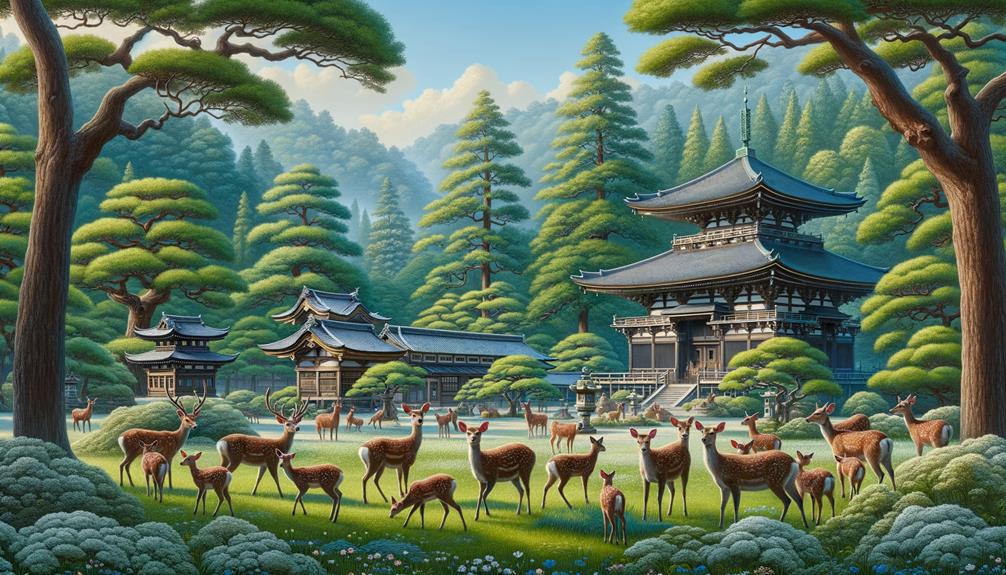
Wandering through the must-see temples and shrines of Nara Deer Park, I was blown away by Todaiji Temple. The massive 15-meter-high Buddha statue left me speechless. As a UNESCO World Heritage Site, the Nandaimon Gate welcomed me with its towering 8-meter-tall Nio guardian figures, their intense expressions almost lifelike. Walking through the gate, I felt a deep sense of history and reverence.
Next, I made my way to Kasugataisha Shrine, where thousands of brass lanterns lined the pathways. The lanterns, both hanging and standing, created a magical atmosphere. Each one seemed to hold a story, a piece of the timeless traditions that surround this sacred place.
Nearby, the peaceful Isuien Garden offered a relaxing retreat. Its traditional Japanese garden design, complete with ponds, teahouses, and seasonal flowers, was a visual treat. I spent a calm hour there, soaking in the meticulously crafted landscape.
Local Cuisine Highlights
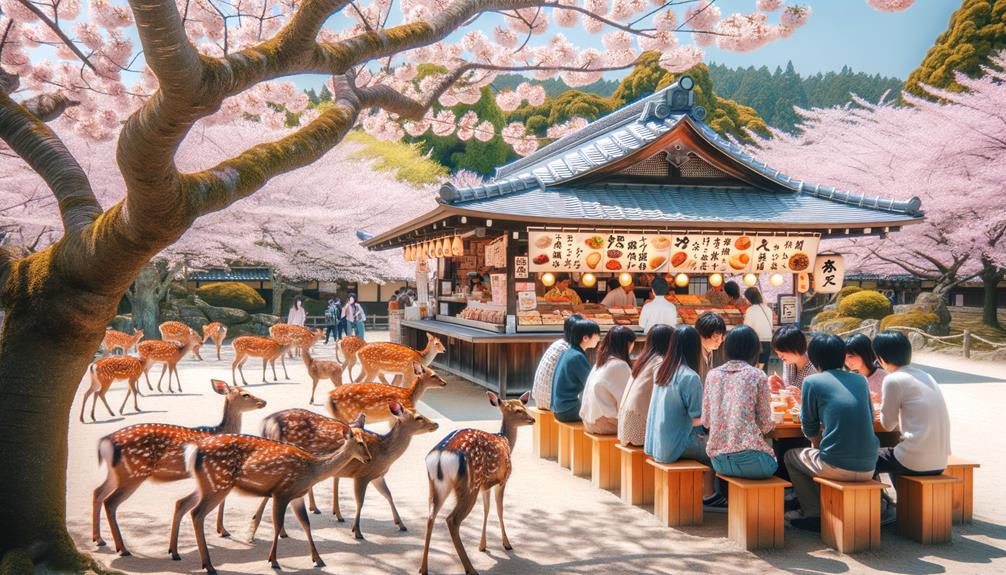
Enjoying Nara's food scene, I quickly noticed that the local cuisine was as rich and varied as its historical landmarks. Just a short walk from Nara Deer Park, I indulged in dishes that tantalized my taste buds and deepened my appreciation for Japanese culinary culture. The standout for me was okonomiyaki, a savory Japanese pancake that perfectly captured the region's flavors.
Nara offers a wide range of dining choices, from cozy spots serving regional dishes to upscale restaurants with traditional Japanese fare. Strolling through the streets, I couldn't resist sampling wagashi, traditional Japanese sweets that provided a delightful contrast to the savory dishes. Each bite was like exploring Nara's culinary heritage.
Eating in Nara is about more than just the food; it's about the experience. Each meal felt like a celebration of local culture, making my visit to Nara Deer Park even more memorable. Here's a quick guide to some of my favorite local treats:
| Dish | Description | Location |
|---|---|---|
| Okonomiyaki | Savory pancake with various toppings | Local eateries |
| Wagashi | Traditional Japanese sweets | Dessert shops |
| Kakinoha-zushi | Sushi wrapped in persimmon leaves | Specialty restaurants |
| Yamato-no-cha | Local green tea | Tea houses |
Exploring Nara's dining scene was a feast for the senses, and I left with a deeper appreciation for the region's culinary traditions.
Shopping and Souvenirs

Strolling through Nara's lively shopping areas, I was drawn to the array of unique deer-themed souvenirs that captured the magic of my visit to Nara Deer Park. The Higashimuki Shopping Arcade was especially vibrant, offering a mix of items that highlighted local artisans' talent and creativity. From delicate deer-shaped cookies to intricately carved wooden figurines, every piece told a story.
I couldn't resist picking up a few eco-friendly items, knowing my purchases supported sustainable practices. One shop had beautifully designed reusable bags with playful deer motifs—practical and charming. Another stall featured hand-painted ceramics, each piece unique and reflective of Nara's natural beauty.
The official Nara Park car park made my shopping trip even easier. After parking, I could explore the shops at my own pace. Walking through the arcade, I felt connected to Nara's cultural heritage, and each souvenir became a cherished memory of my visit. Bringing home these deer-themed treasures meant I could carry a piece of Nara's charm with me long after leaving the park.
Accommodations Near Nara Park
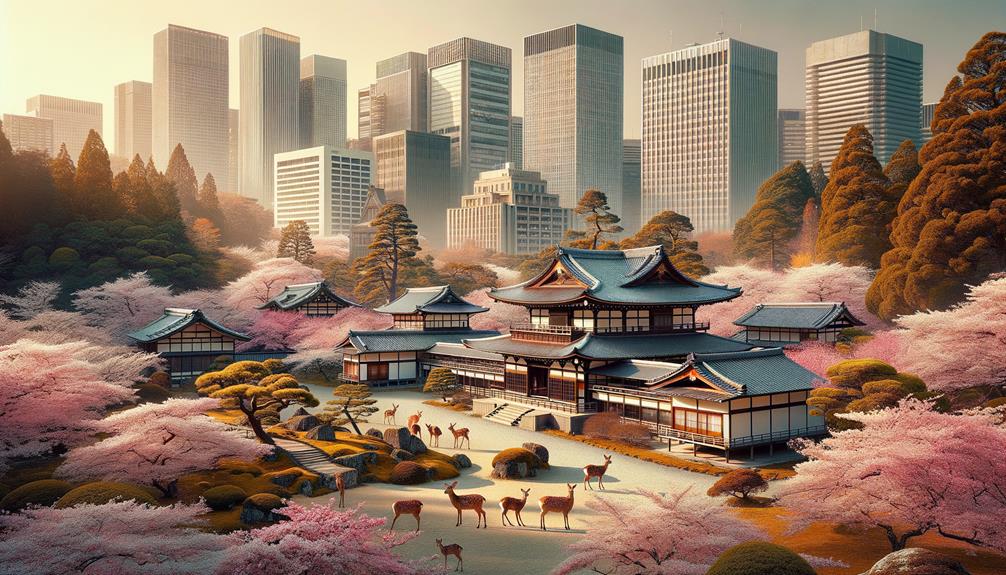
Staying near Nara Park was a wonderful experience, with charming places like the AN-GRANDE HOTEL NARA offering both comfort and convenience. Close to the park, this hotel provided a peaceful escape with modern amenities. The rooms were beautifully designed, and I could almost feel the tranquility of the park through the windows.
For those on a budget, Hotel Pagoda was a great choice. Despite being affordable, it didn't skimp on comfort. Its proximity to the park made it an excellent option for budget travelers who want to stay connected to Nara Park's beauty.
I also stayed at the NARA Visitor Center & Inn, which perfectly blended traditional and modern styles. The staff's warmth and the inn's authentic decor made my stay memorable. For a more intimate setting, the Deer Park Inn offered a peaceful retreat with lovely views of the surroundings.
Another highlight was Mountain Home Lodge, with its rustic charm and excellent service. Each of these accommodations provided easy access to Nara Park, making it simple to enjoy the park's natural and historical beauty every day.
Guided Tours and Transportation

Joining a guided tour of Nara Deer Park gave me a fascinating look into its history, cultural importance, and the intriguing behavior of its deer. Our guide, who knew a lot about local stories, explained that these deer are seen as sacred messengers of the gods. I learned that it's really important to interact with and feed the deer properly, especially since they can get pretty excited around food.
Getting to Nara Deer Park was a breeze. I took a bus from Nara Station, but you can also opt for a private van if you prefer a more personal ride. Once we arrived, our guide made sure we followed all park rules, ensuring both our safety and that of the deer.
One of the best parts of the tour was visiting spots like Todaiji Temple and Kasuga Shrine. These stops added a lot of historical and cultural context to the experience. Watching the deer bow in exchange for special deer crackers was adorable and showed their unique behavior. This tour made my visit to Nara Deer Park both educational and unforgettable.
Frequently Asked Questions
Is Nara Deer Park Worth Visiting?
Absolutely, Nara Deer Park is worth a visit. The serene landscape is stunning, and feeding the friendly deer with special crackers is a unique experience. Plus, the connection to Japan's rich folklore makes it truly unforgettable.
Can You Touch the Deer in Nara?
Yes, you can touch the deer in Nara. It's best to be gentle and respectful since they are wild animals and can be unpredictable. Following the park's guidelines will help ensure both your safety and the deer's well-being.
How Many Hours Should I Spend in Nara?
I recommend setting aside at least three hours to enjoy Nara. Take your time to stroll around, soak in the local culture, and really take in the peaceful vibe. My visit there was unforgettable, and I felt a deep connection with the surroundings.
How Much Does It Cost to Go to Nara Deer Park?
Visiting Nara Deer Park is free of charge. However, you can buy deer crackers for 150 yen. I remember the thrill of feeding those gentle animals, even though they sometimes got a bit pushy.

